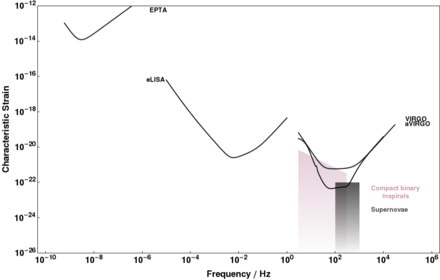Virgo interferometer
The VIRGO is a gravitational wave detector in Italy, which started operating in 2007. It is one of a handful of the world's major experiments working towards the observation of gravitational waves. VIRGO is located within the site of EGO (European Gravitational Observatory) at Santo Stefano a Macerata, Cascina, Tuscany.
Description

VIRGO is a massive Michelson laser interferometer made of two orthogonal arms, each three kilometers long.[2] Due to the multiple reflections between mirrors located at the extremities of each arm, the effective optical length of each arm is extended up to 100 kilometers.
The gravitational wave frequency range sensitivity of VIRGO extends from 10 hertz to 10,000 hertz.[2] This range, as well as the very high sensitivity, should allow detection of gravitational radiation produced by supernovae and the coalescence of binary systems in the Milky Way and in outer galaxies.
In order to reach the extreme sensitivity required, the whole interferometer must remain as optically perfect as possible and is extremely well isolated from seismic disturbances[3] in order to be only sensitive to the gravitational waves. To achieve this, Italian and French project scientists have developed many of the current leading techniques in the fields of high power ultrastable lasers, high reflectivity mirrors, seismic isolation and position and alignment control. To avoid spurious motions of the optical components due to seismic noise; each component is isolated by a 10 m high, very elaborate system of compound pendulums.
Regarding optics, VIRGO uses a new generation of ultrastable lasers and one of the most stable oscillators ever built.[2] A specific optical coating facility was built to produce extremely high quality mirrors combining reflectivity over 99.999%, with nanometer surface control.
Because the presence of any residual gas would disturb the measurements, the light beam must propagate under an ultra high vacuum. Indeed, the two tubes, 3 km long and 1.2 m diameter are the largest ultra high vacuum vessels in Europe and the second largest in the world.
The environment of the Virgo interferometer is quieter than that of a spacecraft orbiting the earth. The signals are detected, recorded and pre-analysed through an on-line computing system. These data will then be made available to the scientific community for further analysis.
History
VIRGO, the construction of which was completed in June 2003, started its first science run in May 2007 and it is currently undergoing upgrades to improve sensitivity.
The project has 48 staffers and runs on an annual 10 million euro budget.[4]

References
- ↑ Moore, Christopher; Cole, Robert; Berry, Christopher (19 July 2013). "Gravitational Wave Detectors and Sources". Retrieved 20 April 2014.
- ↑ 2.0 2.1 2.2 "The VIRGO interferometer". European Gravitational Observatory. Retrieved April 7, 2013.
- ↑ http://ieeexplore.ieee.org/xpl/login.jsp?tp=&arnumber=4998833&url=http%3A%2F%2Fieeexplore.ieee.org%2Fxpls%2Fabs_all.jsp%3Farnumber%3D4998833
- ↑ http://www.icra.it/MG/mg12/talks/gw2_calloni.ppt Commissioning status of the Virgo interferometer, 2009 (Power Point)
External links
Coordinates: 43°37′53″N 10°30′18″E / 43.63139°N 10.50500°E
| |||||||||||||||||||||||||||||||||||||||

